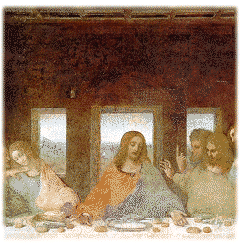
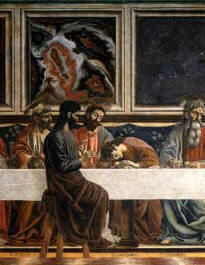
Leonardo Andrea del Castagno
Jesus and Mary Magdalene, the Harlot of the Horde
Nov.13, 2003
The article is a supplement to Pinocchio: The Puberty Rite of a Puppet
Jesus said to her, "Do not hold
me,
for I have not yet ascended
to the Father (John, 20:17)
The verse from the Gospel of John
is quite obscure. What doest it mean? Why Mary Magdalene is not allowed
to hold Jesus until he has ascended to the Father?
We know from the Gospels that after
his Resurrection the women were the first to see him:
There were also many women there, looking on from afar, who had followed Jesus from Galilee, ministering him; among whom were Mary Magdalene, and Mary the mother of James and Joseph, and the mother of the sons of Zebedee (Matt,27:55).And when the sabbath was past, Mary Magdalene, and Mary the mother of James, And Salome, bought spices, so that they might go and anoint him. And very early on the first day of the week they went to the tomb when the sun has risen (Mark,16:1-2)
Now it was Mary Magdalene and Joanna and Mary the mother of James and the other women with them who told this to the apostles; (Luke, 24:10)
While they were talking and discussing together, Jesus himself drew near and went with them (Luke, 24:15)Now on the first day of the week Mary Magdalene came to the tomb early, while it was still dark, and saw that the stone had been taken away from the tomb (John,20:1)
Jesus said to her, "Mary." She turned and said to him in Hebrew, "Rabboni!"(which means Teacher). Jesus said to her, "Do not hold me, for I have not yet ascended to the Father..." (John,20:17)
In Pinocchio I have interpreted the Crucifixion as a puberty
rite. Like the young novices in the bush, Jesus underwent tortures. Like
them, He dies and resurrects.
As a consequence of the rite, the novices identify with
the generation of the fathers, and only at its conclusion they are granted
the sexual license. Under torture and the threat of death, they have learned
the Law of the clan, and they have repressed their lust for the mother.
After the Resurrection, the Virgin Mary does not appear
anymore. She has been successfully repressed. As a reward, the young novice
is now allowed to have sexual intercourse with other women. Henceforth,
there are many women, all Maries, meaning, all replacement of the mother,
the original Mary, but none of them the mother. Like the mother,
but not THE mother.
Many Maries, but the most important is Mary Magdalene,
the harlot. In the Gospel of John, after the Resurrection she stands alone
with Jesus, as if she had been able to get rid of her rivals.
In the Gnostic Gospel of Philip we can catch a glimpse
of the relationship between the two:
And the companion of the [Savior is] Mary Magdalene. [But Christ loved] her more than [all the disciples [and used to] kiss her [often] on her mouth. The rest of [the disciples were offended by it [and expressed disapproval]. They said to him, "Why do you love her more than all of us?" The Savior answered and said to them, "Why do I not love you like her? When a blind man and one who sees are both together in darkness, they are no different from one another. When the light comes, then he who sees will see the light, and he who is blind will remain in darkness" (NHC II.3.63.32ff) (Robinson 1977: 138). in Ramon K. Jusino, Mary Magdalene: Author of the Fourth Gospel?As we also know from the Synoptic Gospels and John, Mary Magdalene was very fond of Jesus, listening to his words (Luke, 10:39-42), following him, and even washing his feet and wiping them with her hair (John 12:3).
The patriarch had only one enemy whom he should dread[...]a youthful band of brothers living together in forced celibacy, or at most in polyandrous relation with some single female captive. A horde as yet weak in their impubescence they are, but they would, when strength was gained with time, inevitably wrench by combined attacks, renewed again and again, both wife and life from the paternal tyrant (Totem and Taboo IV:5, note 1).As I have shown in Pinocchio, the puberty rites of savages enacted again the existential condition of the primal horde, in order to stage an undoing of the primal murder through a reconciliation of the "youthful band" with the generation of the fathers, instead of the original aggression and murder. The youngsters were again driven from their village and from their mothers and sisters to live among themselves and in "forced celibacy", as the conditions had been in the primal horde.
We too believe that the pious solution contains the truth - but the historical truth and not the material truth. And we assume the right to correct a certain distortion to which this truth has been subjected on its return ( Moses and Monotheism (Third Essay, II:G).Freud articulated in a psychoanalytic language what the ancients had already said in their own way:
When I began to write my history I was inclined to count these legends as foolishness, but on getting as far as Arcadia I grew to hold a more thoughtful view of them, which is this. In the days of old those Greeks who were considered wise spoke their sayings not straight out but in riddles, and so the legends about Cronus I conjectured to be one sort of Greek wisdom. In matters of divinity, therefore, I shall adopt the received tradition (Pausanias, Description of Greece 8.8.3).


Now, we can decode the odd verse
from the Gospel: "Jesus said to her, "Do
not hold me, for I have not yet ascended
to the Father (John, 20:17).
The narrative of the Gospels conceals
the latent psychological contents of the primal horde and of the archaic
puberty rites. In those rites the youngsters were demanded to renounce
the incestuous and parricidal drives, and to identify with the generation
of the fathers. The Crucifixion (death) and Resurrection (birth from the
Father instead than from the mother) are the final stage of the puberty
rite. The last stage, for the rite to be successfully completed, is the
full identification of the youngster with the father. Only afterwards,
full sexual license is granted.
In Christian tradition, this last
stage is represented by Jesus' ascending to the Father, and sitting at his
right (Dextera Patris).
Therefore, Mary Magdalene, after Jesus' Resurrection, was not yet allowed to touch him, until
he had ascended to the Father and, in this way, he had successfully completed
his puberty rite.
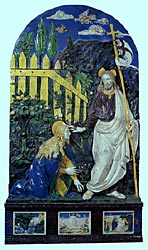
Through art, the psychological truth emerges, as it is shared by the collective unconscious. The psychic background of the primal horde is there, in paintings and statues.
Donatello has
carved out of wood the image of John the Baptist, transfiguration of Dionysus, Goat and Primal Father of Western civilization, usually represented in works of art with his beastly skin and totemic symbol of goat - ram. Donatello has also carved out of wood a similarly beastly image of Mary Magdalene. She is shown dressed with her long hair, which embraces her whole person. Even if the first is dressed with an animal skin, and the second with her own hair, the result is the same: a beastly image of primal apes.
We are suddenly presented with our own unconscious image of the Saints, as members of the archaic horde, and protagonists of the primal tragedy.
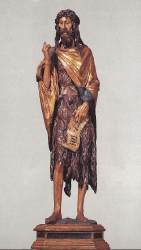
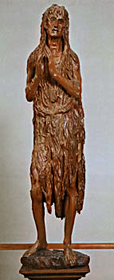
Furthermore, every Saint holds his own symbol, hinting that they are protagonists of a drama represented on the stage. The symbol is the name of the role.
John the Evangelist's symbol is the goblet (Chalice), as he has been painted by Cavallini in The Last Judgment in Santa Cecilia in Rome. The goblet, as every container, is one of the symbols of the woman.
Mary Magdalene holds the ointment goblet, as well.
Courageous, unconcerned, scornful, coercive - so wisdom wisheth us;
she is a woman, and ever loveth only a warrior.
(F.Nietzsche, Thus Spoke Zarathustra, Part I, 7).
At this point, we are able to decode also another thread of Christian tradition. Why is she often represented as penitent, and pouring bitter tears? She is often even called The Repentant Magdalene, as a household name.
The rationalization infers that she is penitent for having been a harlot, even if, as pointed by Jusino, there is nothing in the Gospels' narrative stating explicitly this point.
The latent, unconscious, reason is another. Christianity is a compromise between the murderous band of the Brothers, of which Christ is the delegate, and the Father. Mary Magdalene, the female who had been living in their midst, loving Jesus and sharing His life in exile, is unconsciously perceived also as taking part in the plot for murdering the Father. She is the cheerleader of the Brotherhood horde, instigating them and taking part in their fight. Henceforth, after the reconciliation has taken place, she must be “penitent” for having been the lover of the leader of the band. As Jesus had atoned by Death and Resurrection, she must take her share in the atonement by being “penitent”.
It seems that every horde needs its harlot.
The Israelites, whose wandering in the wilderness and conquest of the Promised Land (the Mother) is equivalent to the wandering in exile of the primal brotherhood horde, met their harlot too:
They went and came into the house of a prostitute whose name was Rahab, and lay there. It was told the king of Jericho, saying, Behold, there came men in here tonight of the children of Israel to search out the land. The king of Jericho sent to Rahab, saying, Bring forth the men who are come to you, who have entered into your house; for they have come to search out all the land. The woman took the two men, and hid them; and she said, Yes, the men came to me, but I didn't know whence they were: and it happened about the time of the shutting of the gate, when it was dark, that the men went out; where the men went I don't know: pursue after them quickly; for you will overtake them. But she had brought them up to the roof, and hid them with the stalks of flax, which she had laid in order on the roof. (Jos. 2:1-5). See Killing God. From the Assassination of Moses to the Murder of Rabin
Links:
Hamlet. The Puberty Rite of a Danish Prince and His Companions
Rembrandt and the Prodigal Son. On Elder and Youngest Sons
Superman and the Myth of the Heroes
John the Baptist
Talking
Socrates and Jesus
The Mary Magdalene of the Israeli Horde
Pinocchio and the Cult of the Trees